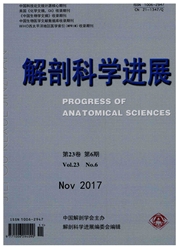

 中文摘要:
中文摘要:
动脉粥样硬化(AS)是血管病变的病理基础,血管内皮功能紊乱是AS病理变化的早期表现之一。硫化氢(H_2S)是继一氧化氮(NO)和一氧化碳(CO)之后的第三个具有生理功能的气体信号分子。H_2S发挥着广泛的生物学效应,对内皮细胞增殖、迁移,抗氧化应激,调节血管紧张度都有一定的影响。H_2S可以使血管舒张,抑制炎症反应和白细胞黏附,抑制血管增殖,抗血栓形成。H_2S是一种还原性气体分子,可以抑制线粒体超活性氧(ROS)的产生,清除或中和ROS,有助于内源性抗氧化分子的生成,进而抑制氧化应激,保护血管内皮,
 英文摘要:
英文摘要:
The vascular complication of diabetes is related to vascular endothelial damage. As a third gasotransmitter, hydrogen sulfide(H2S) is a newly discovered gas signaling molecule after nitrogen oxide and carbon monoxide, plays an important pathophysiological role in many systems and numerous vascular complications of diabetes mellitus, such as proliferation and migration of endothelial cells, anti-oxidation stress, regulation of vascular tone. H2S could cause the vasodilation, the inhibition of inflammation and leukocyte adhesion and vascular proliferation, and anti thrombosis. H2S is a reducibility gaseous molecule, inhibits the production of reactive oxygen species(ROS), such as removal or neutralization of ROS, contributes to the generation of endogenous antioxidant molecules to inhibit oxidative stress, protecting vascular endothelia and maintaining the blood perfusion of organs.
 同期刊论文项目
同期刊论文项目
 同项目期刊论文
同项目期刊论文
 Calcium Sensing Receptor RegulatingSmooth Muscle Cells Proliferation ThroughInitiating Cystathionine
Calcium Sensing Receptor RegulatingSmooth Muscle Cells Proliferation ThroughInitiating Cystathionine Simultaneous Positivity for Anti-DNA, Anti-Nucleosome and Anti-Histone Antibodies is a Marker for Mo
Simultaneous Positivity for Anti-DNA, Anti-Nucleosome and Anti-Histone Antibodies is a Marker for Mo Post conditioning protecting rat cardiomyocytes from apoptosis via attenuating calcium-sensing recep
Post conditioning protecting rat cardiomyocytes from apoptosis via attenuating calcium-sensing recep Akt and Erk1/2 activate the ornithine decarboxylase/polyamine system in cardioprotective ischemic pr
Akt and Erk1/2 activate the ornithine decarboxylase/polyamine system in cardioprotective ischemic pr Exogenous hydrogen sulfide attenuates diabetic myocardial injurythrough cardiac mitochondrial protec
Exogenous hydrogen sulfide attenuates diabetic myocardial injurythrough cardiac mitochondrial protec 期刊信息
期刊信息
